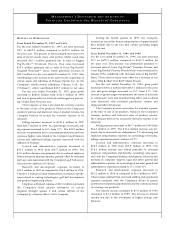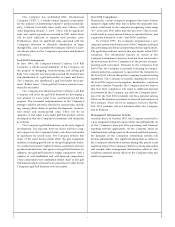Callaway 1997 Annual Report Download - page 17
Download and view the complete annual report
Please find page 17 of the 1997 Callaway annual report below. You can navigate through the pages in the report by either clicking on the pages listed below, or by using the keyword search tool below to find specific information within the annual report.
18
share using the treasury stock method. Dilutive securities
related to the Employee Stock Purchase Plan are calculated
by dividing the average withholdings during the period by
85% of the lower of the offering period price or the mark e t
value at the end of the period. The dilutive effect of rights to
p u r c h a s ep re f e r red shares under the Callaway Go l f
Sh a reholder Rights Plan have not been included as dilutive
securities because the conditions necessary to cause these rights
to be redeemed we re not met. All earnings per common share
data re p o rted in priorperiods have been restated in accor-
dance with SFAS No. 128. A reconciliation of the numerators
and denominators of the basic and diluted earnings per com-
m o ns h a re calculations for the years ended December 31,
1997, 1996, and 1995 is presented in Note 5.
Financial Statement Pre p a r a t i o n
The preparation of financial statements in conformity with
generally accepted accounting principles requires manage-
ment to make estimates and assumptions that affect the
reported amounts of assets and liabilities and disclosure of
contingent assets and liabilities at the date of the financial
statements and the reported amounts of revenues and
expenses during the reporting period. Actual results could
differ from those estimates.
Cash Eq u i v a l e n t s
Cash equivalents are highly liquid investments purchased
with maturities of three months or less. Cash equivalents
consist of investments in money market accounts and U.S.
Treasury bills.
At December 31, 1996, the Company held inve s t m e n t s
in U.S. Tre a s u ry bills with maturities of three months or less
in the aggregate amount of $96,407,000. Management
determines the appropriate classification of its U.S.
Government and debt securities at the time of p u rchase and
re e valuates such designation as of each balancesheet date. T h e
Company recorded these securities at a m o rt i ze d costs and
designated them as “held-to-maturity.” No investments in
U.S. Treasury bills were held at December 31, 1997.
The acquisition of substantially all of the assets
and certain liabilities of Odyssey Sp o r ts , Inc. (Note 11) and
the re p u rchase and re t i rement of certain of the Company’s
outstanding Common Stock necessitated the sale of cert a i n
held-to-maturity debt securities with amort i zed costs of
$115,428,000 and $31,805,000, re s p e c t i ve l y, during 1997.
These securities we re purchased at a discount and we re sold
within two weeks to two months of their re s p e c t i ve stated
maturity dates. As such, the securities are considered to be
sold at maturity under the provisions of SFAS No. 115
“Accounting for Certain In vestments in Debt and Eq u i t y
Securities.” No re a l i zed or unre a l i zed gain or loss re s u l t e d
f rom the sale of these securities.
In v e n t o ri e s
Inventories are valued at the lower of cost or market. Cost
is determined using the first-in, first-out (FIFO) method.
Pro p e rt y, Plant and Eq u i p m e n t
Property, plant and equipment are stated at cost less
accumulated depreciation. Depreciation is computed using
the straight-line method over estimated useful lives of three
to fifteen years. Repair and maintenance costs are charged to
expense as incurred.
L o n g - L i ved Assets
The Company assesses potential impairments to its long-
l i ved assets when there is evidence that events or changes in
circumstances have made recovery of the asset’s carrying
value unlikely. An impairment loss would be recognized
when the sum of the expected future net cash flows is less
than the carrying amount of the asset. No impairment losses
have been identified by the Company.
Intangible Assets
Intangible assets consist primarily of trade name, trademark ,
trade dress, patents and goodwill resulting from the pur-
chase of substantially all of the assets and certain liabilities
of Odyssey Sports, Inc. (Note 11). Intangible assets are
a m o r t i zed using the straight-line method over periods rang-
ing from three to forty years. During 1997, amortization
of intangible assets was $1,778,000. Amortization expense
for the years ended December 31, 1996 and 1995 was
not material.
St o c k - Based Compensation
Effective January 1, 1996, the Company adopted SFAS
No. 123, “Accounting for St o c k - Based Compensation.” T h e
Company will continue to measure compensation expense
for its stock-based employee compensation plans using the
intrinsic value method prescribed by APB Opinion No. 25,
“Accounting for Stock Issued to Em p l oyees.” Pro forma dis-
closures of net income and earnings per share, as if the fair
value-based method prescribed by SFAS No.123 had been
applied in measuring compensation expense, are presented
in Note 6.
Income Ta xe s
Cu r rent income tax expense is the amount of income taxe s
expected to be payable for the current ye a r. A deferre d
income tax asset or liability is established for the expected
f u t u re consequences resulting from the differences in the
financial re p o rting and tax bases of assets and liabilities.
De f e r red income tax expense (benefit) is the net change
during the year in the deferred income tax asset or liability.
























